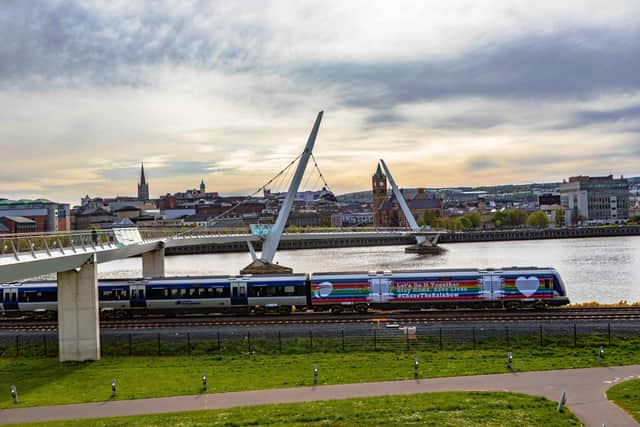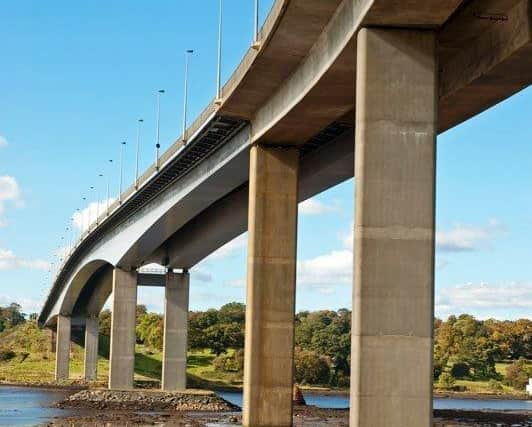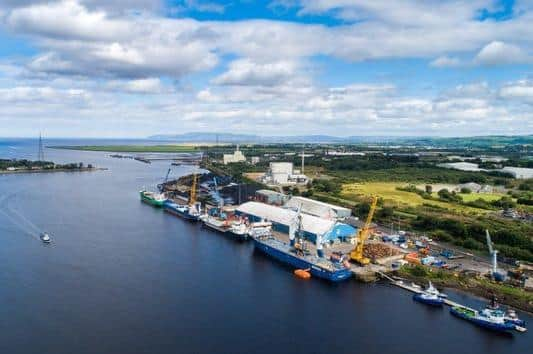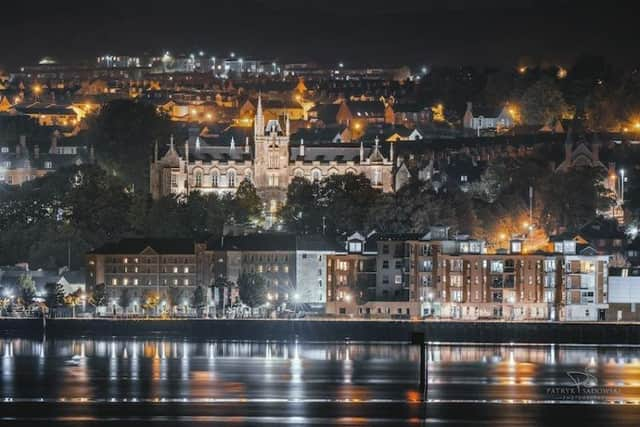Stormont or direct rule: which delivered more for Derry?
and live on Freeview channel 276
MAJOR EXTERNAL PUBLIC INVESTMENTS UNDER DIRECT RULE (1972-1998):
The initial years of direct rule saw few large publicly-funded investments here. But that changed in the 1980s and 1990s when Derry’s city centre and key pieces of its infrastructure were significantly reshaped. It should be noted that some of this was arguably born of necessity as chunks of Derry city Ccntre had been damaged during the Troubles.
1. Foyle Embankment (1979).
Advertisement
Hide AdAdvertisement
Hide Ad

The short section of dual carriageway and riverside walkway between Harbour Square and John Street opened in 1979 on reclaimed riverside land. It enabled a number of other public investments to take place in the following years, particularly along Foyle Street.
2. Foyle Street Urban Park (1979).
This new public park – complete with bandstand, fountains and a sculpture wall – was created in the lower section of Foyle Street at the edge of the city centre. It lasted until the 1990s, when it was demolished to make way for a multi-storey car park and tourist office.
3. Waterside Railway Station (1980).


Derry’s original Victorian railway station on Duke Street was a repeated target for IRA bombings in the 1970s. After four bombs went off there in 1978, the decision was made to replace it with a new, smaller station further along the riverfront.
4. Foyle Bridge (1984).
The mid-1980s saw the River Foyle gain a second crossing point through the creation of the £15.8m Foyle Bridge. It opened up land on both sides of the river for new housing and development, and remained as the longest bridge in Ireland until 2019.
5. The Richmond Centre (1984).
Advertisement
Hide AdAdvertisement
Hide Ad

The ‘Richie’ was the first large-scale regeneration project in Derry city centre since the Troubles began. The 100,000 sq ft facility opened in 1984 – bringing a host of new retail chains to the north-west for the first time as well as new office accommodation.
6. Ulster University, Magee Campus (1984-1995).
In 1984, the New University of Ulster at Coleraine merged with Jordanstown’s Ulster Polytechnic to form University of Ulster. This ushered in a significant long-term investment programme at its Magee campus - with existing buildings refurbished and new ones built on the Rock Road site. Student halls also opened on Strand Rd in 1993, with Duncreggan Student Village and sports facilities following in 1995.
7. Rossville Flats replaced (1985-1989).


The famous ‘high flats’ on Rossville Street were built in the mid 1960s in a move that combined social housing with electoral gerrymandering. The flats were a landmark location in the early years of the Troubles, and by the mid-1980s their condition led the Housing Executive to decide to pull them down. This was completed by 1989, with new low-level housing created in its place.
8. Foyle Street Bus Station (1987).
Prior to the creation of this purpose-built facility on Foyle Street, buses departed from a few different city centre locations. This building brought them together into a single modern facility.
9. City of Derry Airport (1989-1993).
Advertisement
Hide AdAdvertisement
Hide AdIn 1978, the council bought Eglinton Airport to improve transport links for the north-west. A £10.5m programme of major redevelopment followed between 1989 and 1993 to create the new ‘City of Derry Airport’. The work was primarily funded by the EU’s European Regional Development Fund.
10. Derry Central Library (1990).
Having been housed in temporary venues since 1978, Derry finally got its distinctive new Central Library in 1990.
11. The Craft Village & Tower Museum (early 1990s).
Paddy Bogside and the Inner City Trust secured public funding to replace bombed-out sections of the Walled City with reproduction 18th and 19th century buildings in Derry’s Craft Village. They also built the neighbouring Tower Museum/O’Doherty Fort.
12. Foyle Port (1993).
After centuries on the city centre quayside, Foyle Port relocated to its current home at Lisahally in 1993.
13. Redevelopment of Derry’s Quayside (1990s-2000s).
Advertisement
Hide AdAdvertisement
Hide AdWith Foyle Port moved downstream, major redevelopment took place where its docks and warehouses had sat. Over the 1990s and early 2000s, the entire riverfront between Sainsburys and the City Hotel was rebuilt – creating a shopping centre, cinema, supermarket, hotel, shops, cafes, flats, student accommodation, multi-storey car park, and riverside walkway. It should be noted that some of these new structures were only built/completed after the end of direct rule (e.g. City Hotel opened in 2002).
14. Foyleside Shopping Centre (1995).
The early 1990s saw work start on Derry’s biggest shopping centre. Foyleside opened in 1995 and, at 400,000 sq ft, it is four times larger than the nearby Richmond Centre. The creation of Foyleside saw an entire block of the city between Bridge Street, Orchard Street and Foyle Street rebuilt as an outlet for shopping, eating and car-parking.
MAJOR EXTERNAL PUBLIC INVESTMENTS SINCE DEVOLUTION (1998-Present):
As the Troubles had ended a few years before devolution was restored, the era of in-filling or replacing bomb-damaged properties through major public investments also ended. In its place came a promising new dynamic, with large former military sites made available for redevelopment and job creation for the benefit of the city.
1. Ebrington (2003 -to date).
Advertisement
Hide AdAdvertisement
Hide AdIn 2003, the Northern Ireland Executive was gifted the 29 acre former Ebrington barracks site. A quango called ‘Ilex’ was established to manage regeneration of it and Fort George. Expectations were initially high for the historic site, but progress has been glacially slow for two decades now. Ebrington’s former parade ground was opened to the public in 2012 and has hosted a number of events since, but the majority of the buildings facing it are still not occupied. Ilex itself faced significant issues, and a 2015 independent review criticised the company’s failure to secure private investment for the former military bases. Its entire senior management team resigned shortly afterwards and Ilex was wound up in 2016, with the sites placed under Stormont control. Since then, Ebrington has still not reached anywhere close to its full potential - although significant progress has been made recently on key schemes like the new office block and 4 star hotel there.
2. Fort George (2004-to date).
Stormont’s Department for Communities bought the 15 acre former barracks for £12m in 2004 from the Port and Harbour Commission. It then negotiated £3.2m from the Ministry of Defence to decontaminate the site and leave it ready for redevelopment – though that work didn’t complete until 2019. This riverfront site has huge potential, but has been largely empty ever since – except for a publicly-funded Science Park building in one corner (opened 2014). Very ambitious proposals to develop the rest of the land for apartments, cafes, bars, restaurants and offices received approval in 2015 but didn’t progress. It is now the planned location for a new health hub.
3. City of Derry Airport (2006 onwards).
In 2006, the British and Irish governments agreed to invest €15m in the airport’s Terminal building and runway. This resulted in an increase in flights and destinations from the city, largely via Ryanair. The operator started withdrawing services from 2014, however, and in 2017 cut its key London Stansted connection. Westminster stepped in with public funding to keep the London flight going through a different operator. Flights and destinations have started to increase again from the airport recently, but it still requires an annual council subsidy of up to £3.4m to cover its running costs. In March 2022, Stormont agreed to provide £3m to cover those costs for a year, but a request to them for £15m to secure the airport for a 6 year period has gone unanswered.
4. Peace Bridge (2011).
This multi award-winning 235m long foot and cycle bridge opened to the public in 2011. Despite some people here initially questioning the need for the bridge, it instantly became a much-loved icon of the city. The £14m project was funded through an EU peace programme.
5. Guildhall Refurbishment (2010-2013).
Advertisement
Hide AdAdvertisement
Hide AdThis £10m project saw the 129 year old Grade A listed building fully restored inside and out. £5.2m of the funding came from Derry City Council, with £2.75m from the Northern Ireland Tourist Board, and £1.5m from Stormont.
6. Derry-Coleraine Railway Line (2013-current).
When the railway track between Derry and Coleraine was at the end of its lifespan in 2004, the reaction of civil servants at Stormont was to try to shut what was the only remaining rail infrastructure in the west of NI. Lobby group ‘Into The West’ was formed and successfully campaigned to have the decision overturned and the track renewed instead.
That renewal work was planned for 2013 - but, when Derry was awarded City of Culture for that year, the work was instead split into three phases. Phase 1 happened in early 2013.
Phase 2 finished in 2017, and enabled an hourly service to Belfast to be introduced (with a huge rise in passenger numbers). The third and final phase was supposed to take place in 2021 but has been repeatedly delayed. It is now scheduled to complete in 2027 – almost a quarter of a century after the condition of the track was first raised as a major issue. Funding for the Phase 3 work is still not confirmed, however. Until Phase 3 is completed, there can be no increase in the frequency or speed of trains from Derry.
7. North-West Transport Hub (2018).
Advertisement
Hide AdAdvertisement
Hide AdAs rail demand from Derry grew, it became clear that the city’s 1980 ‘lego’ station was no longer fit for purpose. Ilex and Stormont proposed squeezing a new station in beside the Peace Bridge, but a public campaign saw this over-turned in favour of restoring the original historic Duke Street station.
The €27m refurbishment was paid for by EU cross-border funding. The restored station has received multiple awards since it opened in 2018 and passenger numbers from the city have increased dramatically.
8. A6 Road (2022).
After years of delays, work to dual sections of the A6 road between Derry and Belfast finally began in 2017. The 7.7 mile section from the M22 to Castledawson finished in 2021 at a cost of £189m. The £220m 19 mile stretch from Dungiven to Drumahoe is ongoing and due to complete this summer. However, the plan to connect the new A6 and the A2/Clooney Road via a 3 mile Drumahoe to Gransha link was dropped, due to a massive illegal waste dump on the route that Stormont has failed to address for a decade. It is now questionable whether that section will ever happen. Furthermore, one-third of the entire A6 (the Glenshane section) remains single-lane with no plan to change it. It is also important to acknowledge that, whilst the A6 widening is often presented as being about connectivity for Derry, in reality it benefits Belfast and all other towns on route just as much. If anything, failure to dual the Glenshane Pass means that the new section at Toome/Castledawson is of primary benefit to Belfast/Antrim.
CONCLUSION
The 1980s and 1990s proved to be a golden era for investment in Derry – with the city getting a new airport, seaport, train station, bus station, bridge, shopping centres and university buildings amongst others. The balance of external public investment in Derry over that period was certainly higher than it has been since the return of devolution.
Advertisement
Hide AdAdvertisement
Hide AdThe important consideration is how much of that was due to the need to replace bombed out buildings, rather than London largesse.
What isn’t in dispute, however, is that most of the major public investment projects for Derry since the return of devolution have progressed at an inexplicably slow pace, and often only in a piecemeal manner (e.g. Ebrington, Fort George, A6, A5, A2, rail track replacement, university expansion).
And the few major investments that have been fully delivered here under devolution have often had more to do with funding from sources other than Stormont (e.g. Peace Bridge, train station, Guildhall refurb, airport expansion).
When it comes to major infrastructure and enabling investment in Derry, Stormont often appears unable to shift out of neutral gear and actually get projects here over the line – whilst major schemes elsewhere in NI seem able to progress to much shorter timescales, particularly in Belfast.
Advertisement
Hide AdAdvertisement
Hide AdIt is also interesting to note that the impending £210m City Deal funding for Derry originated as a Westminster initiative to regenerate cities, rather than as a Belfast-initiated proposal to address Derry’s clear needs (despite regeneration being a devolved matter).
○ Steve Bradley is a regeneration consultant and PhD candidate. He can be followed on Twitter at @Bradley_Steve.